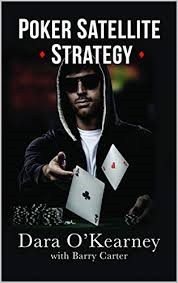
With the World Series of Poker going on, it isn’t surprising to see many players get into the events through satellites. These satellites – which were an innovation created by the WSOP and then-Tournament Director Eric Drache – offer players the opportunity to get into tournaments for much less than what the original buy in is. But what is the right approach in these tournaments?
For quite some time, there hasn’t been a solid treatise about strategy for satellite tournaments…that is, until now. Poker player Dara ‘Doke’ O’Kearney and co-writer Barry Carter have combined on a book called Poker Satellite Strategy that presents a solid approach to take in attacking this format of poker. While it doesn’t put you into those “big league” events, it does offer a road map on how to get there.
Tight is Right, Yes? How about EXTREMELY Tight?
O’Kearney, who has made a habit of winning seats into tournaments across Europe through satellites (and has parlayed that into a million dollars plus in tournament cashes over the last ten years), and Carter present a book that takes the “tight is right” philosophy and puts it on steroids. Because you don’t have to win EVERY chip in a satellite tournament to be a winner – all you have to do is be one of those who makes the cutoff, whatever it may be – O’Kearney and Carter preach a style of play that would be difficult for most in this day of “any two” play. The two gentlemen hammer it into the skulls of the players throughout the book – YOU DON’T NEED TO WIN EVERY HAND, you just need to stay in the hunt.
So, what does it mean to be “in the hunt?” O’Kearney and Carter present a formula that players can use to determine just how many chips are needed to be able to cruise into the satellite reward. Basically, it considers three factors: the seats (or awards) to be handed out, the number of chips that are in the satellite tournament and a determination of a certain level to target. They make this formula even simpler by looking at it as a “bubble” situation, which means that, if you are currently in the position of earning one of the satellite rewards and there are more people “outside” the bubble than you are near the bubble, you can usually back off the action (example: if you are in 70th place with 120 players left and 100 seats are up for grabs, you can relax and, O’Kearney and Carter state, blind your way into the satellite seat – there’s 30 players from you to the bubble and 20 players outside looking in).
This is something that, for me, was a thought that I’d never considered. Something else that I hadn’t considered was the directions by O’Kearney and Carter that playing TIGHTER than normal was the right approach. They were able to get this through in a method that has become lost when it comes to many strategy tomes.
Charts Demonstrate Your Approach Well
One of the things that some poker strategy guides have done of late is not give you the reasonings behind WHY you’re supposed to adopt their approach. Many players talk about how they have run the hands through simulators or they have collected thousands of hand histories that demonstrate they are right, but then they don’t put that information in their books through a graphical presentation – they say, “trust me” and leave it at that. What O’Kearney and Carter do with Poker Satellite Strategy is offer up mathematical charts that show WHY you should be calling with a tighter range than what normally is expected.
O’Kearney and Carter present their evidence through two different paths – graphs where players are all using GTO to make their decisions and one broken down by how many players are left and seats to be awarded. In these demonstrations, they show that tighter play is correct in the GTO process. But it is even MORE important to be EVEN TIGHTER in their other method. O’Kearney and Carter justify this because of the usual “pushfest” nature of satellite events nearing the bubble.
Does this go against everything you’ve always been taught about in tournament poker? Yes, it does. But it is the CORRECT approach because you aren’t trying to get all the chips, you just need to have ONE chip to be able to win the satellite seat. This is something that players don’t often consider, sometimes even if they play satellites frequently, and O’Kearney has made considerable money and satellite seats through this fashion.
Dara O’Kearney and Barry Carter have come up with a nice niche book that will make players think about what they are doing when they sit down for their next satellite tournament. If you’re going to head to the WSOP and try to get in the $10,000 Championship Event on the cheap (or any event – there are satellite tournaments that will offer “lammers” that can be used for entry into other WSOP events), you’d be well advised to pick up a copy of Poker Satellite Strategy, even if it is just for a refresher. It may not be something you’d want to use once you get in that “big league” tournament, but it can make the process of playing satellite events easier and more profitable if you utilize their instructions.























